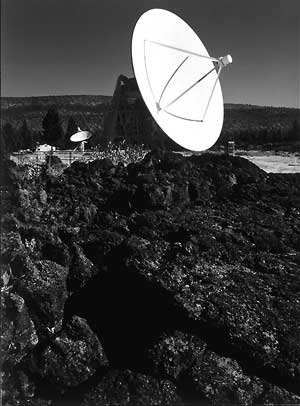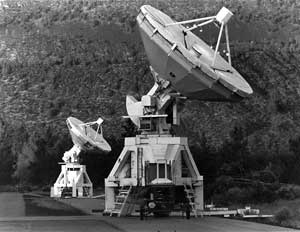UC Berkeley passes management of Allen Telescope Array to SRI
After operating the Hat Creek Radio Observatory for more than 50 years, and most recently partnering with the SETI Institute to build the Allen Telescope Array, UC Berkeley is handing over management to SRI International, which will operate the observatory for the U.S. Air Force. The telescope will track space debris and continue to search for signs of intelligent civilizations.
April 13, 2012
Hat Creek Radio Observatory in Northern California, from which University of California, Berkeley, telescopes – most recently the Allen Telescope Array (ATA) – scanned the Milky Way and other galaxies for 50 years and made numerous discoveries that changed our understanding of the universe, is now under new management.
Effective this month, SRI International, a non-profit organization that also manages the world’s largest radio telescope, the Arecibo Observatory in Puerto Rico, is taking over management from UC Berkeley’s Radio Astronomy Laboratory (RAL).
SRI, located in Menlo Park, Calif., will operate the 42-dish ATA to develop new applications for its state-of-the-art instrumentation, such as space situational awareness. The new agreement allows the Mountain View, Calif.-based SETI Institute, which initiated a search for extraterrestrial intelligence with the ATA in 2007, to continue to use the facility to search for signals from distant technological civilizations with special attention to newly discovered exoplanets.
According to Geoff Bower, ATA director and UC Berkeley professor of astronomy, at its current size, the ATA “can’t compete against other facilities for our scientific goals. The ATA was an incredible technical and scientific demonstrator. We exploited it fully for exciting scientific projects in the study of the violent and variable universe and we are very grateful and appreciative of the support of the Paul G. Allen Family Foundation. The RAL is building on the legacy of technical and scientific innovation with the ATA and moving on to new cutting-edge research projects.”
“We are sad to be moving out of there,” said David DeBoer, deputy director of the ATA. “The ATA really drove the direction of radio astronomy. It was the visible incarnation of techniques being developed to operate arrays of hundreds of radio dishes,” a concept known as large number of small dish (LNSD) arrays.
Two much larger radio arrays replicating this concept are now under construction – the Karoo Array Telescope (KAT) in South Africa and the Australian Square Kilometre Array Pathfinder (ASKAP) – and a third, the Square Kilometer Array (SKA), may be constructed as an international project over the coming decades.
“The plans for SKA look much like the ATA, and that’s not a coincidence,” DeBoer said.
Building a 350-dish array
Dedicated in 2007, the 42-dish ATA was built by UC Berkeley and the SETI Institute with major funding from the Paul G. Allen Family Foundation. After four years of astronomical and SETI observations, it was put into hibernation in April 2011 because funding dried up. It was revived in December, thanks in part to several hundred thousand dollars donated by private individuals that allowed the SETI Institute to re-install their signal processing computer equipment. SRI and the SETI Institute will contribute toward continued operation of the ATA. Four of the six employees laid off at that time have been rehired by SRI.
“It’s a little bit like watching your children grow up to be adults,” said Leo Blitz, who oversaw construction of the ATA as director of the RAL from 1996 to 2010. ”The ATA never reached its full potential because we ran out money before we could build all 350 telescopes, but the concept is something that has now become the paradigm for building low-frequency telescopes.”

Famed photographer Ansel Adams visited the observatory in 1964 and took a photo of the 85-foot radio dish against a foreground lava outcrop.
The Hat Creek Radio Observatory was established by UC Berkeley in 1958 on leased ranchland 70 miles northeast of Redding, Calif., in the remote Hat Creek Valley 20 miles outside Lassen National Park. Astronomers hoped that the radio-quiet site situated amid lava beds would make an ideal location for radio telescopes to listen for faint signals from interstellar gas clouds and the heart of the Milky Way Galaxy.
The first two radio dishes – 33 and 85 feet in diameter, respectively – were completed in 1962, built with funds from the U.S. Office of Naval Research. The 85-foot diameter dish was then one of the largest telescopes in the United States. The larger dish discovered the first hydroxyl molecule (OH) in space, the first interstellar maser – the radio equivalent of a laser – and mapped interstellar clouds of hydrogen and other molecules before it was blown down during a wind storm in 1993.
Early on, UC Berkeley astronomer William “Jack” Welch began building smaller 10- and 20-foot diameter radio dishes to search for millimeter-wavelength radio signals from molecules, and discovered the first complex chemical in space – ammonia – and, in 1968, water.
“I think that was the beginning of bioastronomy, in a way, because water is so important in life systems,” said Welch, who was director of the observatory from 1972 to 1996 and is now a Professor Of the Graduate School. “It really triggered a lot of interest in the issue of, ‘Could there be other places where life as we know it is flourishing?’”
Probing galactic gas and dust
Welch pioneered millimeter-wave interferometry by connecting several small telescopes together to achieve the resolution of a much larger telescope, a technique that allows astronomers to see smaller and smaller objects in space. Using this interferometer array, UC Berkeley astronomers probed gas and dust in the Milky Way and other galaxies as well as planetary atmospheres.
“Hat Creek under Jack Welch was where millimeter interferometry was hatched and went through its teething pains and developments to become the forerunner of the ALMA project, our grown child,” said Blitz, referring to the 66-dish Atacama Large Millimeter Array now being built in the Chilean desert.
The original millimeter-wave dishes expanded in number until in 1987 they became the Berkeley-Illinois-Maryland Array (BIMA), jointly operated by UC Berkeley, the University of Illinois and the University of Maryland.
“Many of the things we take for granted as being part of the star formation process – how dust collapses to form planets and how stars form in the galaxy – were first observed by the BIMA array at Hat Creek,” said Leo Blitz.

Two radio dishes that eventually became part of the BIMA array. (Saxon Donnelly photo, 1967)
The nine 6.1-meter BIMA dishes were bundled up and merged into the Combined Array for Research in Millimeter-wave Astronomy (CARMA) array in California’s Owens Valley in 2004, which helped make way for the ATA.
UC Berkeley astronomers will continue to conduct research at other radio telescopes, including CARMA, which is jointly operated by UC Berkeley, and larger arrays around the world.
The ATA was planned as an array of 350 radio dishes that would offer unparalleled resolution for studying exploding stars, the massive black holes at the cores of distant galaxies and discovering new, exotic astronomical objects. Observing in centimeter wavelengths, the ATA broke new ground as the first panchromatic, wide-angle, snapshot radio camera ever built, and is the most effective tool to create radio images of a vast area of the sky ever placed in the hands of researchers.
Attracted by the potential for astronomy and the search for extraterrestrial intelligence (SETI), Microsoft cofounder and philanthropist Paul Allen donated more than $30 million to the project.
Operating expenses obtained through NSF grants tailed off, however, and for the past two years the array was supported by funds from the U.S. Air Force, to conduct space situational awareness and detect space debris.
“The Hat Creek Radio Observatory has a rich history of important scientific discoveries about space and complex molecules,” said Scott Seaton, vice president of SRI’s Engineering Research & Development Division. “As SRI begins to manage Hat Creek and perform observations, we look forward to expanding the use of the Allen Telescope Array to support the wider scientific community in radio astronomy and space science.”
For more information:
- Radio telescope array dedicated to astronomy, SETI (Oct. 11, 2007 press release)
- Allen Telescope Array begins all-sky surveys (May 27, 2009 press release)
- Out with the BIMA, in with the ATA (Oct. 29, 2004 press release)
- Announcement of plans to build large telescope array (Feb. 8, 1999 press release)